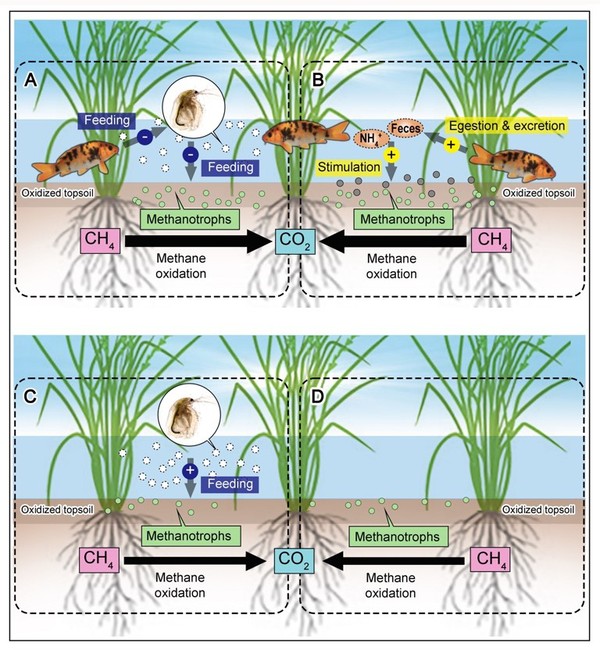How do fish affect soil methane oxidation in the rice-fish system?
On June 20, the laboratory of CHEN Xin and TANG Jianjun at the College of Life Science,Zhejiang University,published an article entitled “Fish mediate surface soil methane oxidation in the agriculture heritage rice–fish system” in the journal Ecosystems. This study reveals how fish affect surface soil methane oxidation through foraging activities that cause trophic cascading and drive nitrogen recycling in the paddy ecosystem.Methane (CH4) emission is affected by the rates of CH4 production and oxidation. The methane oxidation process could help to effectively mitigate CH4 emission. Studies have shown the effects of soil microorganisms, plants, and their interactions in the process of CH4 oxidation, but the effects of animals on this process are less known.
The 1200-year-old rice-fish system in Qingtian County, Zhejiang Province of China, one of the Globally Important Agricultural Heritage Systems (GIAHS) by the Food and Agriculture Organization of the United Nations, preserves an indigenous population of common carp (Cypinus carpio) that has well adapted to the paddy field. The previous experiments by CHEN Xin and TANG Jianjun’ lab showed that the fish widely foraged live foods (e.g. duckweeds, algae, phytoplankton, zooplankton, and zoobenthos) in the paddy. Some of these organisms (e.g. zooplankton Daphnia) feeds on CH4 oxidation bacteria. Based on this evidence, the researchers hypothesized that fish foraging in the rice paddies might affect soil methane oxidation.

To test this hypothesis, the researchers conducted a 5-year field experiments and micro-and mesocosm experiments. They found that rice-fish coexistence in the paddy did not affect methane emissions, but significantly promoted both methanogenic archaea and methane aerobic oxidizing bacteria, and significantly increased the methane oxidation rate in the surface soil. Through food component analyses by δ13C and δ15N and microcosm experiment, the researchers found that the trophic cascade effect triggered by fish foraging in the rice-fish system enhanced the abundance of methane aerobic oxidizing bacteria and accelerated methane oxidation in the surface layer of the soil. Isotope 15N tracing indicated that nitrogen released by the fish accumulated in the surface layer of the soil. 15N labeled DNA stable-isotope probing (15N -DNA-SIP) provided insights into the utilization of fish feces-nitrogen by methanotrophs. Mesocosm experiments further demonstrated that nitrogen released by fish enhanced methanotrophic abundance and increased CH4 oxidation.
This study contributes to a better understanding of how interspecies interactions affect methane emissions and holds scientific significance.